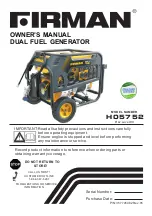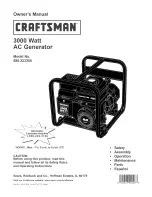
Page 04
WHEN OPERATING EQUIPMENT
•
DO NOT
tip engine or equipment at angle
which causes fuel or oil to spill.
DO NOT
stop engine by moving choke
control to “Start” position.
•
•
WHEN TRANSPORTING, MOVING
OR REPAIRING EQUIPMENT
Transport/move/repair with fuel tank
EMPTY or with fuel
shut OFF.
valve
•
•
DO NOT
tip engine or equipment at angle
which causes fuel or oil to spill.
Disconnect spark plug wire.
•
WHEN STORING FUEL OR EQUIPMENT
WITH FUEL IN TANK
•
WARNING
•
•
WARNING
Generator voltage could cause
electrical shock or burn resulting
in death or serious injury.
•
WARNING
•
•
NEVER
start or stop engine with electrical
devices plugged in and turned on.
WARNING
Gasoline, gasoline vapors and liquid petroleum
gas(LPG) are extremely flammable and explosive
which could cause burns, fire, or explosion resulting
in death or serious injury and/or property damage.
WHEN ADDING OR DRAINING GASOLINE
Turn generator engine OFF and let it cool at
least 2 minutes before removing fuel cap.
Loosen cap slowly to relieve pressure in tank.
Fill or drain fuel tank outdoors.
•
•
DO NOT
overfill tank. Allow space for fuel
expansion.
If fuel spills, wait until it evaporates before
starting engine.
•
Keep fuel away from sparks, open flames,
pilot lights, heat, and other ignition sources.
Check fuel lines, tank, cap, and fittings
frequently for cracks or leaks. Replace if
necessary.
DO NOT
light a cigarette or smoke.
•
•
•
•
WHEN STARTING EQUIPMENT
Ensure spark plug, muffler, fuel cap, and air
cleaner are in place.
•
DO NOT
crank engine with spark plug
removed.
•
Use approved transfer equipment, suitable
for the intended use, to prevent backfeed by
isolating generator from electric utility
workers.
English Customer Service: 1-844-FIRMAN1
Make certain that a LPG cylinder is not attached
to generator and is securely stowed away.
•
Do not store gasoline or LPG cylinder near
furnaces, water heaters, or any other appliances
that produce heat or have automatic ignitions.
•







































